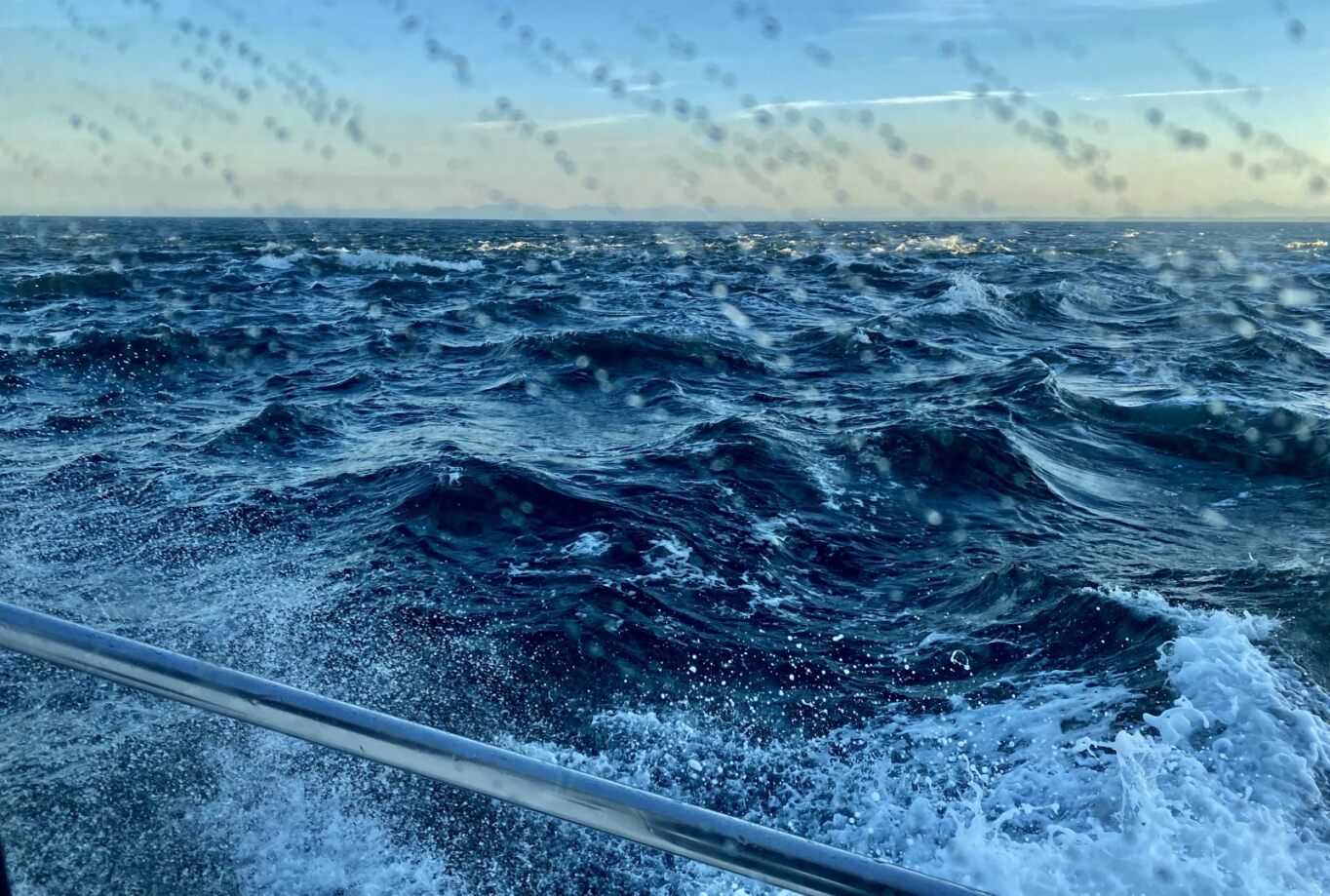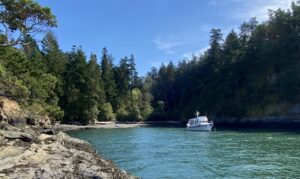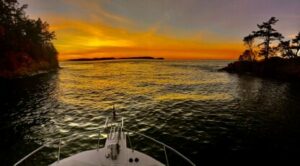It was a beautiful late summer day in the San Juans when my wife-and-first-mate Peggy and I noticed that tiny “Eagle Cove” was open and beckoning us. This is our name for a small, one-boat anchorage between Eagle Point and Rolfe Cove on Matia Island, and seeing it open is a rare and welcome sight. Light northwesterly breezes were coming in directly from our anchorage at Sucia Island, but with little fetch between us and Matia Island, calm seas prevailed.
We pulled up anchor at Sucia in glassy-calm water and set a short course for Matia, just 1.6 miles away. This is a very tight anchorage, and I was mindful of the practical considerations for anchoring, with particular focus on the need to quickly deploy our stern-tie because of the proximity of rock formations along the northern shoreline that dry at low tide, and because of the sheer vertical rock cliff that forms the entire southern edge of the cove. These two factors, along with a seabed that shallows progressively toward shore, make for exceptionally limited swing room when anchored.
We secured First Tracks, our Nordic Tug 37, and enjoyed an afternoon on the flybridge basking in warm sunshine with a very gentle breeze. The peaceful afternoon was spent catching up on reading, exploring tidal pools in the kayak and capturing pictures of a stunningly picturesque sunset with unimpeded views northwest past Sucia Island. Total bliss.
After a relaxing barbecue dinner in the cockpit, we took in the placid mood as the sun dropped toward the horizon.
As the evening wore on, our tranquility was disrupted by a growing breeze and building waves. The direction of the wind had shifted just slightly—but enough—that stiffer breezes were now coming in past Sucia from across the vast expanse of the Strait of Georgia and penetrating deep into the tight cove, causing us to bob up and down like a cork.
In hindsight, perhaps we should have pulled up anchor then, but with fading daylight and the anticipation of waking up to another day in our secluded paradise, I dismissed the warnings of increasing wave activity. We battened down the hatches, stowing everything we could, and hunkered down for some discomfort for an hour or two. Or three, or four, or six, or eight.
Thus began the longest night we have ever spent on anchor in our three decades of boating. The closest comparison was on our previous vessel, a much smaller and lighter Ranger Tug 27, rollicking and rolling across Dixon Entrance, the notorious “gate” along the Inside Passage between Prince Rupert and Ketchikan. But this was different. It was now pitch black and our only movement was vertical rather than horizontal. At least in a crossing one is making headway and can anticipate the relief of a sheltered destination. But throughout this sojourn we could only wait as the uncomfortable minutes turned to anguished, tortured hours.
Now, as the waves built into breakers, the bobbing sensation transformed into us being slammed and shuddered as our bow lifted and hurled back against the sea. Peggy and I, lying in the forward queen berth, were tossed up and down like rag dolls. Closing our eyes to catch badly needed sleep was not even a possibility; instead, we maintained a vigil throughout the night. Prayers were repeated.
The sense of helplessness enveloped us like a cocoon. I would crawl out of bed hourly to check our position. Using our mast-mounted searchlight, the good news was the rocky bluffs on either side of First Tracks were close enough that I could see them to verify our unchanged position. The good news was we had not dragged at all. The bad news was that the ominous rock wall to our port, and the drying rocks to our starboard were so perilously close that I could see them with the searchlight.
Ranger Tug owners considering a journey up the Inside Passage would commonly ask us: “How rough of water can the vessel take?” The answer was comforting: “Typically, more than the crew!” I would contemplate this throughout the long night, somewhat reassured by the fact that our boat was not only four times the displacement of our smaller tug, but unlike a traditional production vessel, ours was custom-built, earning a superb reputation for build quality. I knew this first-hand from having updated all electronics three years prior, necessitating the removal of various internal panels to access wire runs throughout the vessel and visually inspecting how these boats are put together. Surely, the build quality would hold up, wouldn’t it?
Thankfully, it did. Aside from those hourly position checks and worrying which component of our vessel might fail first, my thoughts turned to our departure at first light. With the wind and waves unrelenting, we did not want to contemplate another day or more of this punishment. But escape would be a complex process, given we had three tasks to complete quickly and nearly simultaneously:
1. Remove the anchor bridle (possibly having to hang over the heaving bow pulpit to release the bridle hook from the chain, and then remove the full length of the bridle lines from two cleats).
2. Winch up the chain, which would also release the anchor from the seabed.
3. Undo the stern-tie line.
We needed a plan: this would require coordination between captain and first mate sequentially. As the sun finally brought first light, and with sea conditions unchanged, we commenced our well-rehearsed strategy. With life jackets and headsets on, it was time to take our stations. The Cummins QSB 5.9 diesel engine rumbled to life and was brought up to operating temperature. Both bow and stern thrusters were turned on and tested—just in case—although it was unlikely they would offset the forces of the pounding waves. Peggy bravely stepped into the rocking cockpit, ready to release the stern-tie line at my command. Despite our sleepless night, there was no need for caffeine: we were both wide awake.
With the bridle lines attached well below the sea’s surface, I first had to work the windlass to retrieve some of the chain to expose the bridle hook. Tightly gripping the stainless-steel bow rail, the bridle hook was freed and the loop ends removed from the cleats. The wind now pushed First Tracks forcefully back against the anchor, and I raced back to the lower helm to throttle forward, relaxing the tension on the anchor chain as I began to retrieve the anchor rode that had held fast all night long.
I gave my trusty first mate the command to release the stern-tie. Now, every second counted as our vessel would no longer be secured directionally, so keeping from being pushed broadside to the incoming rollers was critical. But the continued onslaught of waves and breakers pushed First Tracks to port. We angled closer to the sheer rock wall, now just seven metres away, threatening our escape. Released from the seabed, I throttled forward, determined to point First Tracks directly into the teeth of the wind and waves, steering her toward starboard and away from that dark wall of danger.
Then, Peggy screamed through the headset that the stern-tie was tangled on a log and would not come loose. “It’s stuck, I can’t pull it free!” she yelled. We were released from the bow, but not yet from the stern, while creeping ever closer to the hideous black “iceberg” to port.
At that moment, it was an easy choice: “380 horsepower will drive us through these breaking waves to escape the menacing rock wall to port; if we snap the nine-millimetre stern line in half so be it!” Thrusting the throttle forward, the dependable Cummins responded, the propeller dug in hard against the sea, and our 13 tons crashed through the waves, leaving the once-idyllic cove behind. Jailbreak!
Peggy exclaimed that the stern-tie was freed. As we exited the frothing, churning, angry cove, we quickly rounded the western-most tip of Matia Island and within seconds had escaped into protected, placid, peaceful seas. Freedom.
Peggy and I challenge ourselves to find new locations on most outings; and also, to glean new lessons from those experiences. So now from the comfort of my recliner, it is time for some self-reflection. Precisely what did we learn from our Longest Night on Anchor?
Lessons Learned
Consider Fetch: Concern about wind is not limited to strength and direction; but also fetch, defined as the distance along open water or land over which the wind blows or the distance traversed by waves without obstruction. Just a moderate shift in wind direction negated the protection afforded by Sucia Island, extended the long fetch from the Strait of Georgia and allowed the waves to build ominously. Peggy swears these were at least three to four-metre waves (they were less than half that), but with First Tracks effectively a “sitting duck,” those waves felt enormous!
Act Quickly: By the time I recognized the wind shift, and consequently the threat due to fetch, our window of daylight had diminished. I should have pulled anchor sooner (before dinner) and sought a more protected anchorage—before it was too late.
Choice of Anchor: We’ve used a variety of anchor types over the years but have grown most confident with the performance of the Delta-style anchor. We anchor out a lot, and on the Nordic Tug, our anchor roller and bow pulpit can accommodate a much larger size than our previous boat, so we “super-sized” it, going with a massive 30-kilogram anchor that is double the size that is suggested as “minimum” for our boat. As long as the bow pulpit, roller and windlass can handle the size and weight, the larger size (normally) allows us a better night’s sleep.
Anchor Bridle: I use and highly recommend a pre-assembled rigging from Mantus Anchors, but you can also assemble your own. However, there seems to be a lot of confusion about the purpose of the bridle/snubber that is reflected in the many iterations of homemade set-ups that are commonly seen in anchorages today.
Stern-Tie: We use bright yellow polypropylene line that floats and is highly visible, with sufficient length (180 metres) to allow running from the boat to shore and back, even in difficult anchorages. Had we tied off at shore instead of doubling back to the vessel, we could not have departed until the wind and waves calmed to allow safe launching of our dinghy, which would have extended the punishment and risk to both vessel and crew. However, we should have placed a serrated knife near the cockpit in case the line needed to be cut.
[SIDEBAR]
Bridles
Bridles (two lines) and snubbers (single line) serve a similar purpose. They provide a direct link between the chain rode and a strong connecting point on the vessel, while bypassing the windlass. They act like a shock absorber to mitigate shock loads caused by waves and wind which could dislodge the anchor. They also protect deck cleats from shock loads. Unfortunately, many boaters use a relatively short line or improper cordage that lacks sufficient stretch rather than a genuine anchor bridle or snubber.
Our bridle, properly deployed, was very likely the difference-maker in First Tracks staying put that long night vs. dragging anchor or damaging the windlass or other deck hardware. The overall length (exceeding eight metres) of heavy three-strand nylon line provides significant stretch to fulfill its primary mission as a shock absorber. Yes, a shorter line may “snub” the chain from rubbing on the bow roller but lacks sufficient stretch, which is the key to increasing holding power and the primary reason to use an anchor bridle. Properly connected with a bridle, the more rigid chain rode will have ample slack as the tension against the bridle is taking the primary impact of wind and waves, vastly increasing the anchor’s capacity to remain embedded in the seabed—exactly as we experienced.


